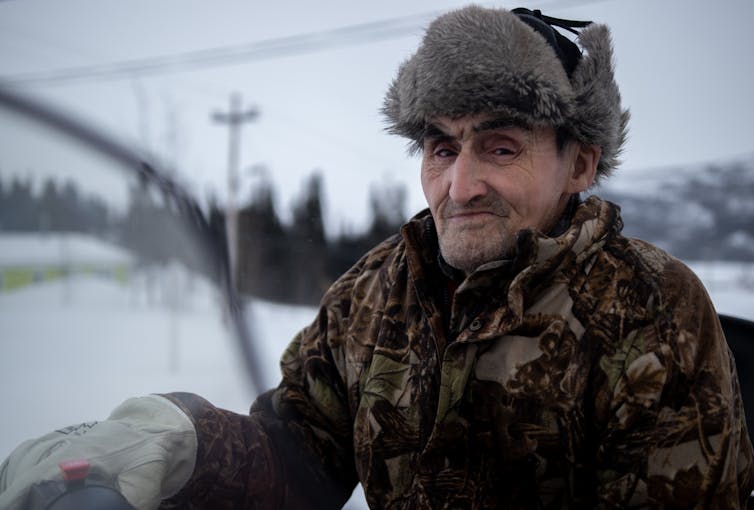, ; , ; ; , , and ,
Inuit in the Nunatsiavut and NunatuKavut regions of Labrador have shared a deep and enduring connection with caribou for many generations. But more recently ŌĆö in the wake of dramatic caribou population declines ŌĆö the communities who depend on them are being faced with a variety of cultural, emotional and health challenges.
Between the 1950s and ŌĆś90s, the population of the grew from about . However, between the 1990s and 2010s, this same herd declined by more than .
Like across the circumpolar North, Inuit have lived through previous caribou population cycles, but the exact causes for the recent declines in Labrador are not fully understood.
In response to these sharp declines, the Government of Newfoundland and Labrador enacted a on caribou in 2013, which remains in place today. Indigenous communities in Labrador have not been legally allowed to hunt caribou for almost a decade.
In order to preserve the relationships between Inuit and caribou, a multi-year documentary film and research initiative began to gather the knowledge of people throughout Labrador. ItŌĆÖs called (or the HERD project).
This Inuit-led project brings together from the Nunatsiavut Government, the NunatuKavut Community Council, the Torngat Wildlife Plants and Fisheries Secretariat, Inuit community members and university-based researchers across Canada.
The HERD project
Between 2016 and 2022, we filmed over 80 Inuit from across 11 distinct communities in Labrador ŌĆö hearing from a diversity of genders, identities, ages and connections to caribou. Through this work we produced several documentary films, one of which is available to view on .
The film is a portrait of the interconnections that exist between Inuit and caribou, a glimpse of the loss felt by communities and a testament of cultural endurance in the context of ecological uncertainty.
As co-creation experts, health-researchers and filmmakers who have worked intimately on this initiative, we have been privileged to hear Inuit stories on caribou and want to ensure their experiences are recognized, and their voices HERD.

Caribou were a vital source of food, and were eaten by many people on a weekly or even daily basis. ŌĆ£The best meat in the world,ŌĆØ said Patrick Davis from Cartwright, NunatuKavut, a sentiment shared by many across Labrador.
But caribou are : ŌĆ£ItŌĆÖs almost like the caribou was the reason, and everything else happened after,ŌĆØ described Joey Angnatok from Nain, Nunatsiavut. These animals connect people to their communities, to the land, and to each other through collective experiences, where place-based knowledge and age-old practices are learned and shared.
A hunting ban with unintended consequences
The caribou population declines, in combination with the total hunting ban, are resulting in major challenges for Inuit across Labrador.
Inuit described how the lack of interactions with caribou have been affecting the ways they see themselves on a personal and community level. ŌĆ£WeŌĆÖre just going to lose who we are as a culture and as a people,ŌĆØ Ocean Lane from Makkovik, Nunatsiavut, explained.
These disruptions to culture and identity have led to complex , including strong feelings of sadness, distress, anxiety, fear, frustration, pain and an overall lack of morale. ŌĆ£It just tears me down to think that we donŌĆÖt even know how long weŌĆÖre gonna have to wait to get to harvest another caribou,ŌĆØ said Woodrow Lethbridge from Cartwright, NunatuKavut.
And, crucially, Inuit expressed sadness that cultural knowledge and practices were not being passed down to younger generations. ŌĆ£WeŌĆÖre losing language. WeŌĆÖre losing traditional ways, and the loss of a food, a cultural food, is just as high of an importance as language, as craft and art,ŌĆØ said Judy Voisey from Happy Valley-Goose Bay.
The future of Inuit-caribou relations
The stories and experiences that were shared through the HERD project emphasize how caribou conservation is not only an ecological process, but is fundamentally connected to culture, mental health, food security and other dimensions of Inuit well-being. The lack of Inuit-caribou interactions poses a major challenge for preserving cultural knowledge and practices.
To support both the health of the herds and communities who rely on them, future caribou-related policies must respect Inuit connections and values. Inuit have already been leading innovative initiatives to maintain cultural skills and knowledge related to caribou, including the project that facilitates youth and Elders to going out on the land and learning about caribou together.
Additional support for Inuit and other for conservation and community well-being must be prioritized.
To learn more about Inuit experiences with caribou declines, visit the .![]()
, Postdoctoral Fellow, School of Arctic and Subarctic Studies, ; , Founding Dean, School of Arctic and Subarctic Studies, Labrador Campus, ; , Community Research Partner; , Adjunct Marine Affairs Program, , and , Canada Research Chair in Climate Change and Health,
This article is republished from under a Creative Commons license. Read the .

